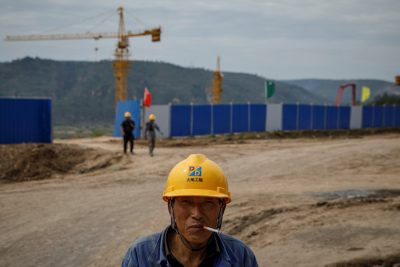China
Power rationing in China is unrelated to Australian coal embargo

Author: Huw Slater, ICF
In December and January, at the height of winter, central and eastern China undertook its most extensive power rationing in a decade. This came as a surprise to international observers, as China’s coal-power sector has run over capacity for years. Average utilisation rates have dropped below 50 per cent nationwide and are as low as 20 per cent in some provinces.
Rationing in Zhejiang, Jiangxi and Hunan provinces raised speculation that coal supply may be impacted by the central government blacklisting Australian imports since October. But before the embargo, Australian exports only accounted for under 3 per cent of coal used for power generation in China. While coastal Zhejiang was a key consumer of Australian coal and Jiangxi receives some via river-borne trade, landlocked Hunan is more dependent on domestic coal.
Several factors led to the rationing. First, the rapid recovery of the Chinese economy post-COVID-19. Second, an especially cold winter in central China. Third, insufficient transmission infrastructure. And fourth, strict energy efficiency targets.
While strict COVID-19 lockdowns impacted economic activity in the first quarter of 2020, stimulus measures led a quick recovery, with year-on-year growth reaching 6.5 per cent by the end of 2020. Electricity generation grew by over 9 per cent year-on-year after being around 5 per cent lower year-on-year in the first quarter. The provinces affected by power rationing saw a surge in demand in December due to increased economic activity and cold temperatures.
High winter demand masks the low level of utilisation and the persistence of a development model that favours cheap finance and subsidies to heavy industry and coal power. The model worked in the decade leading up to the global financial crisis as Chinese exports surged — but demand has flatlined and local governments did not adapt.
Prior to the pandemic, China’s coal-power fleet ran at about 50 per cent of capacity, and by late 2020, plants in Zhejiang and Hunan ran at 40 per cent. At these levels, much of the coal-power fleet will only be needed during peak demand. This is set to decline further as renewables continue growing rapidly. China’s electricity pricing mechanism does not provide peak pricing to incentivise operators’ readiness to ramp up if called upon, leading to a supply crunch once the post-COVID-19 industrial surge kicked in.
In December, Hunan saw a peak load of over 33 gigawatts (GW) — over 10 per cent higher than that seen the previous year, and exceeding local dispatchable generation capacity by about 4 GW. On 7 January, Jiangxi saw a peak load of 28 GW — about 16 per cent higher than a year earlier, roughly 6 GW beyond dispatchable capacity. For perspective, Australia’s coal-power fleet capacity is about 25 GW.
At least 4 GW in Hunan were offline due to what was described as technical faults, though speculation is that this was a case of operators refusing to operate at a loss due to high coal prices. Hydro, solar and wind power output were also impacted by the cold weather.
The central grid region, to which Hunan and Jiangxi belong, has 330 GW of thermal and hydropower, and should cope with an overall peak load of 164 GW. But the grid is not as well integrated internally or connected externally as it should be. Plans to increase capacity in coming years should add some stability to the central grid. Improving intra-grid transmission, such as connection to Sichuan and Hubei hydropower resources, would also help.
Hunan said it was entering a ‘war state’ to deal with power issues, requiring industrial and commercial users to avoid consumption during peak hours. Jiangxi also intervened to shave morning and evening peak loads, asking companies to reduce usage, limiting street and other lighting and quoting national policy on the need to limit unreasonable demand for electricity.
In Zhejiang, the heaviest restrictions on power usage were in the city of Yiwu. The provincial government issued special restrictions between 12–31 December, intended to help ‘win the energy battle’ of improving energy efficiency and controlling total energy consumption. It included electricity quotas for everything from government departments to karaoke bars. Some factories were temporarily closed and some essential production had to be run with diesel generators.
A Yiwu city official commented that the measures were due to ‘energy conservation and emission reduction policies’. The Zhejiang government’s 2018 targets aimed to achieve reductions in…
China
Is journalist Vicky Xu preparing to return to China?

Chinese social media influencers have recently claimed that prominent Chinese-born Australian journalist Vicky Xu had posted a message saying she planned to return to China.
There is no evidence for this. The source did not provide evidence to support the claim, and Xu herself later confirmed to AFCL that she has no such plans.
Currently working as an analyst at the Australian Strategic Policy Institute, or ASPI, Xu has previously written for both the Australian Broadcasting Corporation, or ABC, and The New York Times.
A Chinese language netizen on X initially claimed on March 31 that the changing geopolitical relations between Sydney and Beijing had caused Xu to become an expendable asset and that she had posted a message expressing a strong desire to return to China. An illegible, blurred photo of the supposed message accompanied the post.
This claim was retweeted by a widely followed influencer on the popular Chinese social media site Weibo one day later, who additionally commented that Xu was a “traitor” who had been abandoned by Australian media.
Following the publication of an ASPI article in 2021 which exposed forced labor conditions in Xinjiang co-authored by Xu, the journalist was labeled “morally bankrupt” and “anti-China” by the Chinese state owned media outlet Global Times and subjected to an influx of threatening messages and digital abuse, eventually forcing her to temporarily close several of her social media accounts.
AFCL found that neither Xu’s active X nor LinkedIn account has any mention of her supposed return to China, and received the following response from Xu herself about the rumor:
“I can confirm that I don’t have plans to go back to China. I think if I do go back I’ll most definitely be detained or imprisoned – so the only career I’ll be having is probably going to be prison labor or something like that, which wouldn’t be ideal.”
Neither a keyword search nor reverse image search on the photo attached to the original X post turned up any text from Xu supporting the netizens’ claims.
Translated by Shen Ke. Edited by Shen Ke and Malcolm Foster.
Asia Fact Check Lab (AFCL) was established to counter disinformation in today’s complex media environment. We publish fact-checks, media-watches and in-depth reports that aim to sharpen and deepen our readers’ understanding of current affairs and public issues. If you like our content, you can also follow us on Facebook, Instagram and X.
Read the rest of this article here >>> Is journalist Vicky Xu preparing to return to China?
China
Guide for Foreign Residents: Obtaining a Certificate of No Criminal Record in China

Foreign residents in China can request a criminal record check from their local security bureau. This certificate may be required for visa applications or job opportunities. Requirements and procedures vary by city. In Shanghai, foreigners must have lived there for 180 days with a valid visa to obtain the certificate.
Foreign residents living in China can request a criminal record check from the local security bureau in the city in which they have lived for at least 180 days. Certificates of no criminal record may be required for people leaving China, or those who are starting a new position in China and applying for a new visa or residence permit. Taking Shanghai as an example, we outline the requirements for obtaining a China criminal record check.
Securing a Certificate of No Criminal Record, often referred to as a criminal record or criminal background check, is a crucial step for various employment opportunities, as well as visa applications and residency permits in China. Nevertheless, navigating the process can be a daunting task due to bureaucratic procedures and language barriers.
In this article, we use Shanghai as an example to explore the essential information and steps required to successfully obtain a no-criminal record check. Requirements and procedures may differ in other cities and counties in China.
Note that foreigners who are not currently living in China and need a criminal record check to apply for a Chinese visa must obtain the certificate from their country of residence or nationality, and have it notarized by a Chinese embassy or consulate in that country.
Foreigners who have a valid residence permit and have lived in Shanghai for at least 180 days can request a criminal record check in the city. This means that the applicant will also need to currently have a work, study, or other form of visa or stay permit that allows them to live in China long-term.
If a foreigner has lived in another part of China and is planning to or has recently moved to Shanghai, they will need to request a criminal record check in the place where they previously spent at least 180 days.
There are two steps to obtaining a criminal record certificate in Shanghai: requesting the criminal record check from the Public Security Bureau (PSB) and getting the resulting Certificate of No Criminal Record notarized by an authorized notary agency.
This article is republished from China Briefing. Read the rest of the original article.
China Briefing is written and produced by Dezan Shira & Associates. The practice assists foreign investors into China and has done since 1992 through offices in Beijing, Tianjin, Dalian, Qingdao, Shanghai, Hangzhou, Ningbo, Suzhou, Guangzhou, Dongguan, Zhongshan, Shenzhen, and Hong Kong. Please contact the firm for assistance in China at china@dezshira.com.
China
China Unveils Plan to Upgrade Industrial Equipment

China unveiled a comprehensive action plan for upgrading industrial equipment, with a focus on driving technological innovation and economic growth. The plan, released on April 9, 2024, aims to enhance competitiveness and sustainability within the manufacturing sector through extensive investment and regulatory support.
China announced an ambitious action plan for industrial equipment upgrading, which aims to drive technological innovation and economic growth through extensive investment and regulatory support.
On April 9, 2024, China’s Ministry of Industry and Information Technology (MIIT) and six other departments jointly released a notice introducing the Implementation Plan for Promoting Equipment Renewal in the Industrial Sector (hereafter referred to as the “action plan”).
Finalized earlier on March 23, 2024, this comprehensive action plan addresses critical issues related to technological innovation and economic development. It reflects China’s proactive stance in enhancing competitiveness and sustainability within its manufacturing sector. The initiative underscores the recognition of industrial equipment upgrading as a top policy priority.
The scope of China’s action plan to upgrade industrial equipment in manufacturing, is extensive, covering various aspects such as:
In line with China’s ambitious goals for industrial modernization and sustainable development, the action plan outlines several key objectives aimed at driving substantial advancements in the industrial sector by 2027.
These objectives encompass a wide range of areas, from increasing investment to enhancing digitalization and promoting innovation, including:
The objectives and key actions proposed in the action plan are summarized below.
This article is republished from China Briefing. Read the rest of the original article.
China Briefing is written and produced by Dezan Shira & Associates. The practice assists foreign investors into China and has done since 1992 through offices in Beijing, Tianjin, Dalian, Qingdao, Shanghai, Hangzhou, Ningbo, Suzhou, Guangzhou, Dongguan, Zhongshan, Shenzhen, and Hong Kong. Please contact the firm for assistance in China at china@dezshira.com.






